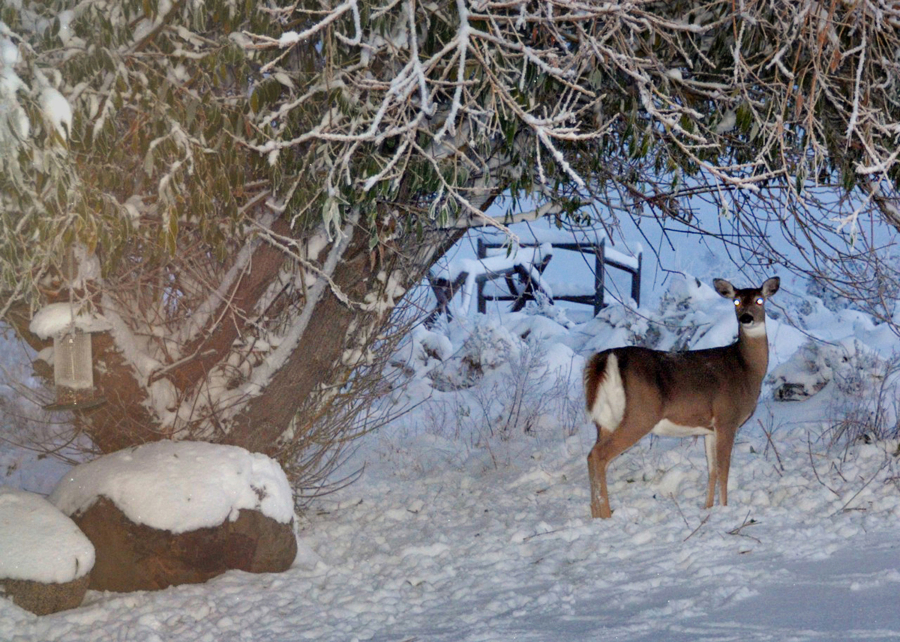A new report from the Pew Charitable Trust shows climate change, along with other human-caused factors, is altering wildlife migration patterns in Idaho and across the West, leading to less healthy animals and population declines.
The Wyoming Migration Initiative used information from GPS collars on deer, elk, pronghorn and other migratory animals to create the report for Pew. It found that climate change, habitat loss, fences, roads and development are impacting the way wildlife move between summer and winter ranges.
“Most of the information in the (report’s) maps that you see is information we didn’t have even five or 10 years ago,” said Matt Skroch, Pew’s project director for Public Lands and Rivers Conservation, in a phone interview. “That’s what’s new and exciting here. There’s so much more information available today about how animals migrate.”
Skroch, who helped write the report, said the new information allowed Pew to offer policy recommendations that could help wild animals continue their migrations.
According to the Pew report, rising temperatures linked to climate change have resulted in drought, extreme wildfires and change in the timing and location of plant growth.
“A lot of people don’t associate wildlife movement with climate change,” Kathy Rinaldi, the Idaho conservation coordinator for the Greater Yellowstone Coalition, said in a phone interview. “With a warming and drying climate, we’re already starting to see changes in precipitation, which ultimately changes vegetation.”
For migrating herbivores, that can mean less food or poorer quality food. In some cases, vegetation may stop growing in places it previously grew, or it may grow earlier or later in the season than it traditionally did due to changes in temperature.
All of this can mean migrating animals arrive to their usual feeding grounds to find there isn’t enough to eat. When vast areas are impacted by wildfire — something that has become more frequent in recent decades, with larger, hotter fires more common now — the same thing can happen.
“Animals pass that migration knowledge down,” Rinaldi said. “Mothers pass it onto their calves and on down the chain based on knowledge within the herd. They don’t know (if an area) burned.”
In addition, when landscapes in Idaho burn, native grasses and brush can be displaced by invasive plants that don’t provide proper nutrition for wildlife.
“The intensity and scope of wildfires in the West, combined with invasive species challenges that we have in many places and persistent drought that many areas in the West are experiencing — all those things combined place a lot of stress and challenges on migrating wildlife populations,” Skroch said.
Rinaldi said warmer temperatures can be hard on big game animals, which can’t regulate their body temperatures as easily as some other species. Higher temperatures can also be a boon for potential harmful insect and parasite species. For instance, Rinaldi said, with average winter temperatures trending slightly warmer, ticks are able to survive on host animals year-round. Early research has suggested that ticks and other parasites may be driving a decline in moose populations in Idaho and across the U.S.
Skroch said wildlife can often adapt to natural phenomena like drought or wildfire if they’re able to move around their habitat to find sufficient food. But other human factors, like fences, roadways, new residential developments and recreation can destroy or isolate those habitat areas.
“Connectivity and permeable landscapes — for migration in the traditional sense or just ‘room to roam’ — is going to be an increasingly important part of our management response to climate change,” Skroch said.
The Pew report lays out suggestions for reducing habitat fragmentation. That can mean closing some areas in the winter to avoid disturbing wildlife, creating overpasses or other routes around barriers and creating land use plans that account for wildlife corridors.
“Our hope would be that organizations and stakeholders in Idaho can take the underpinnings and use them, along with information the Idaho Department of Fish and Game has, to think about what management decisions (can benefit wildlife),” Skroch said.
Often those decisions will need to be made in concert with private landowners and state and federal agencies. Skroch pointed to the Sand Creek elk herd in eastern Idaho as an example. Those animals spend the summer in Yellowstone but return to the Sand Creek Wildlife Management Area near Ashton for the winter. The herd crosses National Park Service, Forest Service, Bureau of Land Management, state and private land on its route.
“(Sand Creek) is one of the largest elk herds in the lower 48, and it’s an incredibly important resource for Idaho,” Skroch said. “That herd absolutely depends on its ability to migrate back and forth in the Greater Yellowstone Ecosystem every spring and fall. There’s a strong economic interest for Idaho to work collaboratively to maintain those corridors.”
©2022 The Idaho Statesman. Visit idahostatesman.com. Distributed by Tribune Content Agency, LLC.



